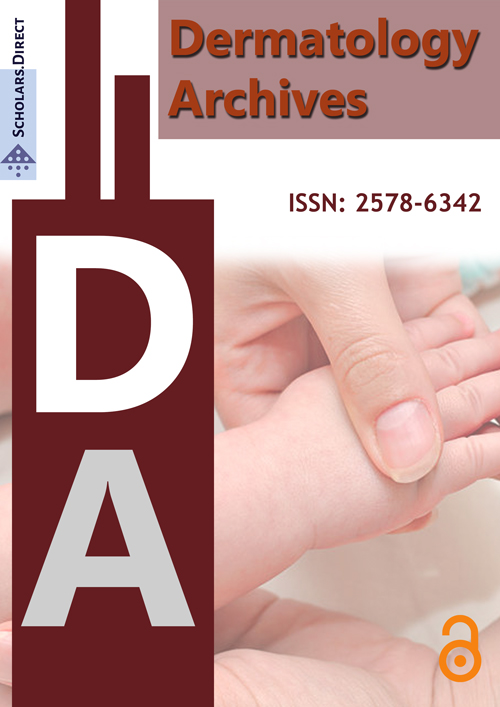Epidemiological and Laboratory Study of Acne Vulgaris in Women in Basrah City
Abstract
Background: Acne vulgaris is a chronic inflammatory disease of pilosebaceous units characterized by open and closed comedones, erythematous papules and pustules, and in more severe cases, nodules, deep pustules, pseudocysts, and scarring. It is the most common dermatological condition worldwide. This study aimed to provide an overview of the various clinical aspects of acne vulgaris among women and to compare the epidemiological and laboratory parameters between different groups.
Methods: A cross-sectional study was conducted to compare the epidemiological and laboratory data of different groups of women with acne vulgaris. Women with a full history and clinical dermatological examination from March 2022 to May 2024 were enrolled. The study enrolled 125 women (mean 20.29 ± 12.88 years) with acne vulgaris were classified into three groups: G-1 adolescent acne, G-2 early adult onset acne, and G-3 post-adolescent acne.
Results: The mean duration of disease was (55.1 ± 38.7) months. Patients in groups G-2 and G-3 who used cosmetics on their face were more frequently women. Involvement of the forehead and check was more frequently observed in G-1, while the lower face and chin were more frequently involved in G-3. Trunk lesions were more frequent in the G-1 group than in the other groups. Hirsutism was found in (36.25%, 32.5%, and 28%) of cases in G-1, G-2, and G-3, respectively. The majority of patients with G-1 (78.5%) had mild to moderate acne, while (77.5%) of G-2 had moderate to moderately severe acne, and (72%) of G-3 patients had moderately-severs to severe acne. Pitted scarring was the most frequent type of scarring in all the age groups.
Conclusions: Age, duration of acne, family history, early onset of cosmetic use, and moderate obesity are predisposing factors that affect the development and severity of acne. The wide distribution of acne lesions, the severe form of acne, and the difficulty of intervention.
Keywords
Acne vulgaris, Adolescent acne, Fitzpatrick phototype, Early onset acne, Androgen hormones
Introduction
Acne vulgaris is a chronic inflammatory disease of the pilosebaceous unit (comprising the hair follicle, hair shaft, and sebaceous gland), and clinically has open and closed comedones, erythematous papules, and pustules, and in more severe cases, nodules, deep pustules, pseudocysts, and possible scarring [1]. It is resulting from androgen-induced raised sebum production, altered keratinization, inflammation, and bacterial colonization of hair follicles on the face, neck, chest, and back by Cutibacterium acnes [2,3]. The resulting appearance can lead to anxiety, reduced self-esteem, and in extreme cases, depression or thoughts of suicide [4].
It is the most common dermatological condition worldwide, affecting more than 700 million people affected [5]. Most people experience acne during adolescence; > 95% of teenage boys and 85% of teenage girls are affected [6]. The Global Burden of Disease Study 2010 found that acne vulgaris is the 8 th most common skin disease [7]. The prevalence is estimated to range from 35% to 100% in adolescents with acne at some point [8]. In Iraq, acne vulgaris was found in 293 (7.02%) of the 4169 samples, which was ranked 5 th among all skin diseases [9].
In Basrah, a household survey reported a high of 17% prevalence of acne [10]. Acne appears earlier in girls, but more boys are affected during the mid-teenage years [11].
It is diagnosed on the basis of the clinical decisions of a medical professional. The management of patients with suspected acne includes taking a detailed medical history about a family history of acne, a review of medications taken, and signs or symptoms of excessive production of androgen hormones, cortisol, and growth hormone [12].
Acne can be classified clinically according to the form of non-inflammatory lesions, including closed (whiteheads) and open (blackheads) comedones, followed by inflammatory lesions, including superficial lesions, such as papules, deep pustules or nodules, and cystic lesions [12]. Acne can also be classified according to severity as mild, moderate, or severe according to patient age and disease onset [4].
Ii improves around the age of 20 years, but may persist into adulthood [13]. Up to 95% of patients with acne have scars, and 30% develop severe scars [11].
The main point in the prevention of acne is the management of the modifiable risk factors implicated in its development, including underlying systemic diseases and lifestyle factors. Dietary habits and obesity may influence acne development. Decreasing the consumption of fat, sugar, sweets, nuts, chocolates, and oily foods has been associated with decreased acne severity [14].
Different and many treatment modalities of acne are available, and a wide range of combination products have been used, which offer numerous treatment options to various patients with different preferences [5,11,14-16].
This study aimed to provide an overview of the various clinical aspects of acne vulgaris among Iraqi women and to compare the epidemiological and laboratory parameters between different groups.
Methods
Study design and setting
A cross-sectional study was conducted to compare the epidemiological and laboratory data of different groups of women with acne vulgaris attending the Dermatology and Verenology Outpatient Clinic, Al-Sayyab Teaching Hospital, and Department of Dermatology, Basrah Teaching Hospital, Basrah, Iraq. Women with a full history and clinical dermatological examination from March 2022 to May 2024 were enrolled.
Participants
The study enrolled 125 women (mean 20.29 ± 12.88 years) with acne vulgaris were classified into three groups: G-1 adolescent acne (aged 12-19 years), G-2 early adult onset acne (aged 20-25 years), and G-3 post-adolescent acne (aged > 25 years).
Inclusion criteria
• Clinically acneouse cases
• Age between 10-40 years
• Well and comfortable cases
Exclusion criteria
• The patient received any therapy (anti-androgen therapy, oral CCP, systemic antibiotics, or isotretinoin therapy).
• Loss of follow-up
• Uncomfortable cases
• Un-signature cases
Data collection
The data included age and occupation, drug history, smoking habits, use of cosmetics, first-degree family history, menstrual history (regularity and irregularity), obstetric history (pregnancy and history of contraceptive pills), signs of hyperandrogenism (hirsutism, androgenic alopecia, infertility, and change of voice), and obesity.
Dermatological assessment
Each female was examined for the distribution of acne lesions, whether facial (forehead, check, perioral, and lower face) or extra-facial (trunk, shoulder, neck, and flexural); types of acne (non-inflammatory (no. for open- and closed-comedones), and inflammatory (no. of papules, pustules, nodules, and cysts), history of previous acne, types of scars (fitted, rolling, boxcar, keloid, hypertrophic scar), types of skin (dry or oily), and types of skin color [17]. The severity of acne was recorded using the Cunliffe scale [18] as mild, moderate, moderately severe, and severe. Body mass index (BMI) was calculated to assessed obesity [19].
Investigations
Laboratory workup included serum levels of total testosterone (TST), dehydroepiandrosterone sulfate (DHEAS), luteinizing hormone (LH), follicular stimulating hormone (FSH), and prolactin (PRL). The normal range of values was also recorded [20].
Ethical approval
The study in accordance with Scientific Council of Dermatology, Department of Dermatology, Al-Sayyab Teaching Hospital, Basrah Health Directorate.
Statistical analysis
Statistical Package for Social Science (SPSS, Chicago, IL, USA) software version 20 was used. The results were described in the form of frequency and percentage for qualitative data, and the quantitative data were expressed as mean and SD. One way ANOVA used to compare the means of the three samples. A one-sided P value of < 0.05 was considered statistically significant.
Results
Their ages ranged from to 10-40 years (mean = 20.29 years). According to the age of onset of acne symptoms, G-1 mean age was 17.29 years, G-2 mean age was 21.45 years, and G-3 mean age was 28.75 years, as shown in Table 1.
The mean duration of disease was (55.1 ± 38.7) months in the G-3 group, which was significantly higher than that in the other groups (p = 0.05). In relation to a family history of acne, more than 60% of cases were found in all groups. The results showed that patients in groups G-2 and G-3 who used cosmetics on their face were more frequently women (80%), with a statistically significant difference (p = 0.01). The mean BMI in all groups and their values were within the normal range, with no statistical difference between the groups. Regarding the Fitzpatrick phototype of skin, there was no association between the types and groups (Table 2).
The distribution of the acne lesions is presented in Table 3. Involvement of the forehead and check was more frequently observed in G-1, while the lower face and chin were more frequently involved in G-3 than in the other groups (p = 0.05). Trunk lesions were more frequent in the G-1 group than in the other groups (p = 0.04).
Seborrhea was observed in all groups, with no statistically significant difference. Hirsutism was found in (36.25%, 32.5%, and 28%) of cases in G-1, G-2, and G-3, respectively, with a statistically significant difference (p = 0.01). However, a high percentage of irregular menstrual cycles was found in all the groups, with a highly significant association (p < 0.0001) (Table 4).
The majority of G-1 (78.5%) had mild to moderate acne, while (77.5%) of G-2 had moderate to moderately severe acne, and (72%) of G-3 patients had moderate to severe acne, with a strong significant association (p < 0.0001), as shown in Table 5. Pitted scarring was the most frequent type of scarring in all the age groups. No hypertrophic scars were observed in any group (Table 5).
Hormonal states were evaluated using the following tests (LH, FSH, DHEA-S, S. testosterone, and S. prolactin), and the results are shown in Table 6. The androgen hormone levels (TST and DHEA-S) were significantly elevated (p = 0.05). DHEAS levels were significantly more frequently elevated in all groups than in the TST group (p = 0.02).
Discussion
In our study, acne was persistent in adolescents in the majority of patients (17.6%), which is in concordance with the study by Geller, et al. [21], where 82% of the population had persistent acne.
For the G-1 mean age was (17.29) years, for G-2 was (21.45) years and for G-3 was (28.75) years. These findings are consistent with the results of a study by Choi, et al. [22], in which adolescent acne is the most frequent type of acne seen in a population. There is still controversy regarding the age of onset-related classification of acne; some authors regarded adolescent acne onset range from to 12-19 years like Sharma, et al. [23] in India, Naif, et al. [24] in Iraq, while post-adolescent acne started beyond the age of 25 years, while others Holzmann and Shakery [25], Bagatin, et al. [26] in Brazil, and Khunger and Kumar [27] in India, pointed out that adolescent acne age of onset may be extended to 24 years and post-adolescent acne after the age of 25 years.
In all groups, 65% of females in this study had a positive family history of first-degree relatives, which is consistent with other studies [23,25]. In relation to acne and cosmetics, the data showed females in the G-2 and G-3 groups used cosmetics more frequently, which is in agreement with other studies [22]. It has been reported that the hair removal process, use of topical cosmetic products, and oral herbal remedies or oral steroid intake are positively related to acne vulgaris aggravation [24]. However, Chalky, et al. [28] reported no significant differences between the severity of acne vulgaris and the use of makeup. Cosmetic products believed to aggravate acne include oil-based cosmetics, pomades, and moisturizers [25].
Our study showed that the mean BMI in the adolescent acne group was within the normal range, while it was overweight in the G-2 and G-3 groups. It has been demonstrated that obesity increases androgens, insulin, insulin-like growth factor, and growth hormone secretion, and in acne patients, the association between serum levels of IGF-1, DHEAS, dehydroepiandrosterone, acne lesion counts, and sebum production have been reported to result in acne formation [29].
Our study showed that involvement of the forehead and check was more frequently seen in adolescent acne than in other groups, while involvement of the lower face, chin, and trunk was more frequently seen in G-3. These findings are in agreement with published literature [22,26,27].
In our study, mild to moderate acne was frequent in adolescent acne, moderate to moderately severe acne was frequently seen in early adult-onset acne, and severe acne was more commonly seen in G-3. These findings are consistent with those of previously published studies [27,30].
Scarring was even more frequent in the G-3 group than in the adolescent acne and early adult-onset acne groups. These findings are in agreement with published literature in which adolescent acne is mostly moderate in severity and post-adolescent acne is usually more severe and predominantly inflammatory, may be resistant to treatment, and raises the risk of scarring [27].
Many studies have reported that atrophic scars are the most frequent, particularly in women with mandibular presentation, hyperseborrhea, and erythema [31,32]. Scars are an important permanent sequela of acne. Up to 95% of acne cases have scars, with 30% developing severe scars [27,33].
In our study, we found that the clinical signs and biochemical parameters of hyperandrogenism were evident in all groups, but with variable percentages. Hirsutism and irregular menstruation are more commonly seen in post-adolescent acne than in early adult-onset and adolescent acne groups. This is in agreement with the results of Khunger and Kumar [27].
Biochemical hyperandrogenism, including raised TST and DHEAS, is more commonly observed in the early adult-onset acne and post-adolescent acne groups than in the adolescent acne group, suggesting that hormonal influence at excess androgens plays an essential pathological role in early adult-onset acne and post-adolescent acne than in adolescent acne patients. Hormonal evaluation in terms of serum levels of TST, DHEAS, LH, FSH, and prolactin (PRL) was performed by Khunger and Kumar [27], which was in agreement with our findings. In a cross-sectional, retrospective study, the androgenic hormone profile of 835 female patients with acne > 15 years of age showed that 54.6% of participants with signs of hyperandrogenism were most frequently elevated [34]. In a recent cross-sectional study, androstenedione and testosterone levels were found to be higher in patients with acne than in healthy controls [11].
Conclusions
Age, duration of acne, family history, early onset of cosmetic use, and moderate obesity are predisposing factors that affect the development and severity of acne. Division of acne onset according to age, providing an easy method for management. The wide distribution of acne lesions, the severe form of acne, and the difficulty of intervention. Adolescent women had mild to moderate acne, early adult female had moderate to moderately severe acne, and post-adolescent women had moderate to severe acne. The greater the persistence of chronic and severe acne types. Excessive hormonal changes, female morphology, and maturity have a direct effect on acne development and severity.
Funding Statement
None.
Ethical Compliance
All procedures performed in this study involving human participants were in accordance with the ethical standards of the institutional and/or national research committee and with the 1964 Helsinki Declaration and its later amendments or comparable ethical standards.
Conflict of Interest Declaration
The authors declare that they have no affiliations with or involvement in any organization or entity with any financial interest in the subject matter or materials discussed in this manuscript.
References
- Layton AM (2010) Disorder of the Sebaceous Glands. Rook's Textbook of Dermatology. Tony Burns, Stephen Breathnach, Neil Cox, Christopher Griffiths. (8 th edn), London Blackwell Publishing Company 42.1-89.
- Williams HC, Dellavalle RP, Garner S (2012) Acne vulgaris. Lancet 379: 361-372.
- Vary JC Jr (2015) Selected disorders of skin appendages: Acne, alopecia, hyperhidrosis. Med Clin North Am 99: 1195-1211.
- Barnes LE, Levender MM, Fleischer AB, et al. (2012) Quality of life measures for acne patients. Dermatol Clin 30: 293-300.
- Danby FW (2015) Acne: Causes and practical management, First Edition. John Wiley & Sons, Ltd. Published, 1-3, 26-28, 31-33, 42-44, 54, 93-101, 103, 109-111.
- Ghodsi SZ, Orawa H, Zouboulis CC (2009) Prevalence, severity, and severity risk factors of acne in high school pupils: A community-based study. J Invest Dermatol 129: 2136-2141.
- Vos T, Flaxman AD, Naghavi M, et al. (2012) Years lived with disability (YLDs) for 1160 sequelae of 289 diseases and injuries 1990-2010: A systematic analysis for the Global Burden of Disease Study 2010. Lancet 380: 2163-2196.
- Heng AHS, Chew FT (2020) Systematic review of the epidemiology of acne vulgaris. Sci Rep 10: 5754.
- Moradi Tuchayi S, Makrantonaki E, Ganceviciene R, et al. (2015) Acne vulgaris. Nat Rev Dis Primers 1: 15029.
- Abd Al Hassan AT (2011) The pattern of skin diseases in Karbala city: A retrospective study. QMJ 7: 117-128.
- Zaenglein AL (2018) Acne vulgaris. N Engl J Med 379: 1343-1352.
- Al-Rubiay KK, Al-Rubaiy LK (2005) Dermato-epidemiology: A household survey among two urban areas in Basrah City, Iraq. Internet J Dermatol 4: 1-7.
- Orion E, Wolf R (2014) Psychologic factors in the development of facial dermatoses. Clin Dermatol 32: 763-766.
- Gollnick H, Cunliffe W, Berson D, et al. (2003) Management of acne: A report from a Global Alliance to Improve Outcomes in Acne. J Am Acad Dermatol 49: S1-S37.
- Strauss JS, Krowchuk DP, Leyden JJ, et al. (2007) Guidelines of care for acne vulgaris management. J Am Acad Dermatol 56: 651-663.
- Nast A, Dréno B, Bettoli V, et al. (2012) European evidence-based (S3) guidelines for the treatment of acne. J Eur Acad Dermatol Venereol 26: 1-29.
- Ward WH, Lambreton F, Goel N, et al. (2017) Clinical Presentation and Staging of Melanoma. In: Ward WH, Farma JM, Cutaneous Melanoma: Etiology and Therapy [Internet]. Brisbane (AU): Codon Publications, TABLE 1, Fitzpatrick Classification of Skin Types I through VI.
- Cunliffe WJ, Meynadier J, Alirezai M, et al. (2003) Is combined oral and topical therapy better than oral therapy alone in patients with moderate to moderately severe acne vulgaris? A comparison of the efficacy and safety of lymecycline plus adapalene gel 0.1%, versus lymecycline plus gel vehicle. J Am Acad Dermatol 49: S218-S226.
- World Health Organization (2024) A healthy lifestyle - WHO recommendations.
- Fauci AS, Braunwald E, Kasper DL, et al. (2018) HARRISON`s a Principles of Internal Medicine. (20 th edn), The McGraw-Hill Companies, Inc. USA, p: Clinical chemistry, appendix (A2).
- Geller L, Rosen J, Frankel A, et al. (2014) Perimenstrual flare of adult acne. J Clin Aesthet Dermatol 7: 30-34.
- Choi CW, Lee DH, Kim HS, et al. (2011) The clinical features of late onset acne compared with early onset acne in women. J Eur Acad Dermatol Venereol 25: 454-461.
- Sharma RK, Dogra S, Singh A, et al. (2017) Epidemiological patterns of acne vulgaris among adolescents in North India: A cross-sectional study and brief review of literature. Indian J Paediatr Dermatol 18: 196-201.
- Naif AAH, Alkhafaji ATT, Hassan BA (2015) Acne vulgaris in Iraq; new predisposing factors. Thi-Qar Medical Journal (TQMJ) 10.
- Holzmann R, Shakery K (2014) Postadolescent acne in females. Skin Pharmacol Physiol 27: 3-8.
- Bagatin E, Timpano DL, Guadanhim LR, et al. (2014) Acne vulgaris: Prevalence and clinical forms in adolescents from Sao Paulo, Brazil. An Bras Dermatol 89: 423-435.
- Khunger N, Kumar C (2012) A clinico-epidemiological study of adult acne: Is it different from adolescent acne? Indian J Dermatol Venereol Leprol 78: 335-341.
- Chalky KRF, Al-Dabbagh SA, Al-Dabbagh ZS (2016) Acne vulgaris: The prevalence, severity and the associated factors among secondary school students in a District of Kurdistan region/Iraq. Duhok Med J 10: 58-68.
- Melnik BC, Schmitz G (2009) Role of insulin, insulin-like growth factor-1, hyperglycaemic food and milk consumption in the pathogenesis of acne vulgaris. Exp Dermatol 18: 833-841.
- Chiu A, Chon SY, Kimball AB (2003) The response of skin disease to stress: Changes in the severity of acne vulgaris as affected by examination stress. Arch Dermatol 139: 897-900.
- Skroza N, Tolino E, Mambrin A, et al. (2018) Adult acne versus adolescent acne: A retrospective study of 1,167 patients. J Clin Aesthet Dermatol 11: 21-25.
- Rivera R, Guerra A (2009) Management of acne in women over 25 years of age. Actas Dermosifiliogr 100: 33-37.
- Uhlenhake E, Yentzer BA, Feldman SR (2010) Acne vulgaris and depression: A retrospective examination. J Cosmet Dermatol 9: 59-63.
- da Cunha MG, Fonseca FL, Machado CD (2013) Androgenic hormone profile of adult women with acne. Dermatology 226: 167-171.
Corresponding Author
Muataz Abdullah Abdulrahman Alrahmani, Department of Dermatology, Basrah Teaching Hospital, Basrah Health Directorate, Ministry of Health, Basrah, Zip: 61001, Iraq, Tel; +9647703102800.
Copyright
© 2024 Al-Edani USR, et al. This is an open-access article distributed under the terms of the Creative Commons Attribution License, which permits unrestricted use, distribution, and reproduction in any medium, provided the original author and source are credited.




